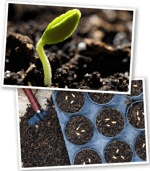Whether you are growing edibles or ornamental plants, a good reason to grow from seed is the fact that you often have a far greater choice of varieties to choose from to grow compared with already grown seedling punnets in-store. Growing heirloom vegetables and old-fashioned flowering annuals can be a really fun and rewarding exercise. It is also really cost effective!
The number of seeds in a packet compared with a punnet of seedlings is far better value. The average packet of seeds may be around $3-4 compared to $4 for a punnet of seedlings but you will get only 6-8 plants in a punnet for that amount compared to 50-1000 in the packet of seed depending on variety. Plus, you can get a jump start on the season.
Direct Sowing vs. Container Sowing
 Some edibles and flowers are best sown directly into the garden. Edibles such as, all your root crops; carrot, beetroot, radish, parsnip, turnip and swede. This is because they detest their roots being disturbed after producing adult leaves and this occurs when they are being transplanted into the garden. Other vegetables that do best sown directly are the legumes; beans, snow peas and peas and the larger seeds such as zucchini, squash, and pumpkin. As a general rule of the thumb it’s the larger seeds that prefer to be directly sown. Flower seeds such as nasturtiums and sunflowers also prefer the direct sow method.
Some edibles and flowers are best sown directly into the garden. Edibles such as, all your root crops; carrot, beetroot, radish, parsnip, turnip and swede. This is because they detest their roots being disturbed after producing adult leaves and this occurs when they are being transplanted into the garden. Other vegetables that do best sown directly are the legumes; beans, snow peas and peas and the larger seeds such as zucchini, squash, and pumpkin. As a general rule of the thumb it’s the larger seeds that prefer to be directly sown. Flower seeds such as nasturtiums and sunflowers also prefer the direct sow method.
Fine seeds, for example lettuce are best sown into punnets/containers and then transplanted once more established.
Growing from seed
What you'll need:
 Seed trays or appropriate containers that will hold mix
Seed trays or appropriate containers that will hold mix- Rocky Point Seed & Cutting Mix
- Seeds (check date and season)
- Liquid seaweed
- Plant labels – paddle pop sticks and a marker pen will do
How to:
- Have your Rocky Point Seed & Cutting Mix on hand
- Select your container of choice – punnets, coir pots, recycled containers, seed raising trays. If using recycled containers, ensure it is washed before use and has some drainage holes
- Fill the container with Seed & Cutting Mix, tap down gently and press firmly.
- Gently water the mix.
- Sow seeds to a depth of 2-3 times their diameter. No deeper. For fine seeds, sprinkle them over the mix and then cover with a small amount of mix.
- Water in gently with a liquid seaweed solution.
- Label – plant name and date.
- Keep warm, moist (not wet) and in a semi-shaded location until germination (a mini greenhouse maybe beneficial).
- Thin and prick out seedlings once they have germinated and grown a set of adult leaves. Transplant the stronger seedlings to a larger container or plant them in ground. This needs to be done carefully as to not damage the new roots. Keep the strongest of the seedlings and discard the weaker ones when thinning out.
Grow what's in season:
Sowing seeds out of season will mean generally poor and probably no germination at all.
 Keep reading more from Claire Bickle, our Better Earth Ambassador in Better Earth Secrets.
Keep reading more from Claire Bickle, our Better Earth Ambassador in Better Earth Secrets.
Get your free copy when you subscribe below;
_MEB.png?width=842&height=596&name=RP_HorizontalColour(R)_MEB.png)




